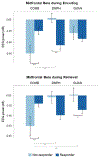Electrophysiological and Clinical Predictors of Methylphenidate, Guanfacine, and Combined Treatment Outcomes in Children With Attention-Deficit/Hyperactivity Disorder
- PMID: 35963559
- PMCID: PMC9911553
- DOI: 10.1016/j.jaac.2022.08.001
Electrophysiological and Clinical Predictors of Methylphenidate, Guanfacine, and Combined Treatment Outcomes in Children With Attention-Deficit/Hyperactivity Disorder
Abstract
Objective: The combination of d-methylphenidate and guanfacine (an α-2A agonist) has emerged as a potential alternative to either monotherapy in children with attention-deficit/hyperactivity disorder (ADHD), but it is unclear what predicts response to these treatments. This study is the first to investigate pretreatment clinical and electroencephalography (EEG) profiles as predictors of treatment outcome in children randomized to these different medications.
Method: A total of 181 children with ADHD (aged 7-14 years; 123 boys) completed an 8-week randomized, double-blind, comparative study with d-methylphenidate, guanfacine, or combined treatments. Pretreatment assessments included ratings on ADHD, anxiety, and oppositional behavior. EEG activity from cortical sources localized within midfrontal and midoccipital regions was measured during a spatial working memory task with encoding, maintenance, and retrieval phases. Analyses tested whether pretreatment clinical and EEG measures predicted treatment-related change in ADHD severity.
Results: Higher pretreatment hyperactivity-impulsivity and oppositional symptoms and lower anxiety predicted greater ADHD improvements across all medication groups. Pretreatment event-related midfrontal beta power predicted treatment outcome with combined and monotherapy treatments, albeit in different directions. Weaker beta modulations predicted improvements with combined treatment, whereas stronger modulation during encoding and retrieval predicted improvements with d-methylphenidate and guanfacine, respectively. A multivariate model including EEG and clinical measures explained twice as much variance in ADHD improvement with guanfacine and combined treatment (R2= 0.34-0.41) as clinical measures alone (R2 = 0.14-.21).
Conclusion: We identified treatment-specific and shared predictors of response to different pharmacotherapies in children with ADHD. If replicated, these findings would suggest that aggregating information from clinical and brain measures may aid personalized treatment decisions in ADHD.
Clinical trial registration information: Single Versus Combination Medication Treatment for Children With Attention Deficit Hyperactivity Disorder; https://clinicaltrials.gov; NCT00429273.
Keywords: attention-deficit/hyperactivity disorder; electroencephalography; guanfacine; methylphenidate; predictor.
Copyright © 2022 American Academy of Child and Adolescent Psychiatry. Published by Elsevier Inc. All rights reserved.
Figures



Similar articles
-
Methylphenidate, Guanfacine, and Combined Treatment Effects on Electroencephalography Correlates of Spatial Working Memory in Attention-Deficit/Hyperactivity Disorder.J Am Acad Child Adolesc Psychiatry. 2023 Jan;62(1):37-47. doi: 10.1016/j.jaac.2022.06.017. Epub 2022 Aug 10. J Am Acad Child Adolesc Psychiatry. 2023. PMID: 35963558 Free PMC article. Clinical Trial.
-
Effects of d-Methylphenidate, Guanfacine, and Their Combination on Electroencephalogram Resting State Spectral Power in Attention-Deficit/Hyperactivity Disorder.J Am Acad Child Adolesc Psychiatry. 2016 Aug;55(8):674-682.e1. doi: 10.1016/j.jaac.2016.04.020. Epub 2016 May 21. J Am Acad Child Adolesc Psychiatry. 2016. PMID: 27453081 Free PMC article. Clinical Trial.
-
Cognitive Effects of Stimulant, Guanfacine, and Combined Treatment in Child and Adolescent Attention-Deficit/Hyperactivity Disorder.J Am Acad Child Adolesc Psychiatry. 2016 Aug;55(8):667-73. doi: 10.1016/j.jaac.2016.05.016. Epub 2016 Jun 7. J Am Acad Child Adolesc Psychiatry. 2016. PMID: 27453080 Free PMC article. Clinical Trial.
-
Comparative efficacy and tolerability of medications for attention-deficit hyperactivity disorder in children, adolescents, and adults: a systematic review and network meta-analysis.Lancet Psychiatry. 2018 Sep;5(9):727-738. doi: 10.1016/S2215-0366(18)30269-4. Epub 2018 Aug 7. Lancet Psychiatry. 2018. PMID: 30097390 Free PMC article.
-
Evaluation of the current data on guanfacine extended release for the treatment of ADHD in children and adolescents.Expert Opin Pharmacother. 2020 Mar;21(4):417-426. doi: 10.1080/14656566.2019.1706480. Epub 2020 Jan 23. Expert Opin Pharmacother. 2020. PMID: 31971448 Review.
Cited by
-
Aberrant amplitude of low-frequency fluctuation and functional connectivity in children with different subtypes of ADHD: a resting-state fNIRS study.BMC Psychiatry. 2024 Dec 18;24(1):919. doi: 10.1186/s12888-024-06350-6. BMC Psychiatry. 2024. PMID: 39696119 Free PMC article.
-
Treatment biomarkers for ADHD: Taking stock and moving forward.Transl Psychiatry. 2022 Oct 12;12(1):444. doi: 10.1038/s41398-022-02207-2. Transl Psychiatry. 2022. PMID: 36224169 Free PMC article. Review.
-
Translating Decades of Neuroscience Research into Diagnostic and Treatment Biomarkers for ADHD.Adv Neurobiol. 2024;40:579-616. doi: 10.1007/978-3-031-69491-2_20. Adv Neurobiol. 2024. PMID: 39562458 Review.
-
Can response to ADHD medication be predicted?Eur Child Adolesc Psychiatry. 2025 Jan 29. doi: 10.1007/s00787-025-02650-8. Online ahead of print. Eur Child Adolesc Psychiatry. 2025. PMID: 39875602
-
Noradrenergic Modulation of Learned and Innate Behaviors in Dopamine Transporter Knockout Rats by Guanfacine.Biomedicines. 2023 Jan 15;11(1):222. doi: 10.3390/biomedicines11010222. Biomedicines. 2023. PMID: 36672730 Free PMC article.
References
-
- Cortese S, Adamo N, Del Giovane C, et al. Comparative efficacy and tolerability of medications for attention-deficit hyperactivity disorder in children, adolescents, and adults: a systematic review and network meta-analysis. Lancet Psychiatry. 2018;5(9):727–738. doi:10.1016/S2215-0366(18)30269-4 - DOI - PMC - PubMed
-
- McCracken JT, McGough JJ, Loo SK, et al. Combined Stimulant and Guanfacine Administration in Attention-Deficit/Hyperactivity Disorder: A Controlled, Comparative Study. Journal of the American Academy of Child & Adolescent Psychiatry. 2016;55(8):657–666.e1. doi:10.1016/j.jaac.2016.05.015 - DOI - PMC - PubMed
-
- Connor DF, Findling RL, Kollins SH, et al. Effects of guanfacine extended release on oppositional symptoms in children aged 6-12 years with attention-deficit hyperactivity disorder and oppositional symptoms: a randomized, double-blind, placebo-controlled trial. CNS Drugs. 2010;24(9):755–768. doi:10.2165/11537790-000000000-00000 - DOI - PubMed

